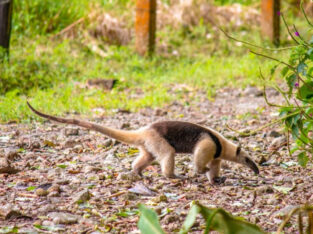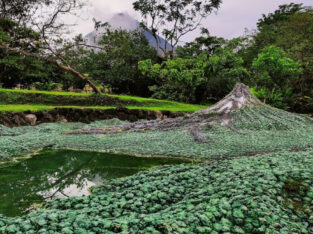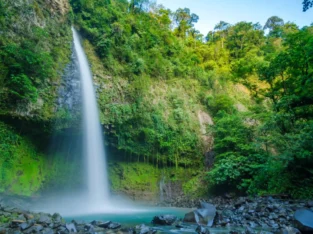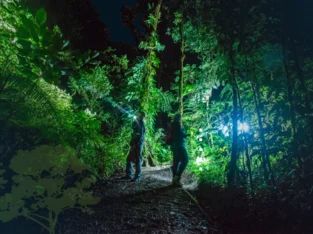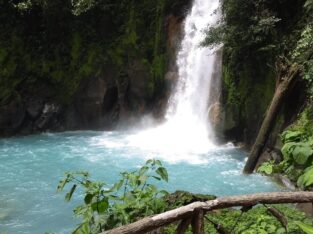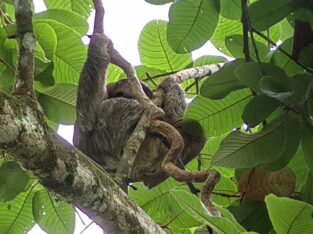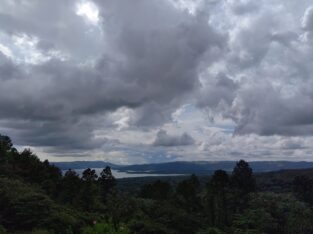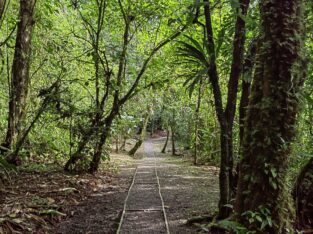Discover Costa Rica
7 provincias (Alajuela, Cartago, Guanacaste, Heredia, Limón, Puntarenas, San José), divididas en 81 cantones, subdivididos en 421 distritos.
Costa Rica is one of the most visited tourist destinations in the world. The variety of landscapes and microclimates that can be enjoyed in the same day make this country a paradisiacal destination. In only 51,000 square km you can find: sun, tropical beaches, adventure, nature and culture; necessary components to satisfy the taste of thousands of tourists who find their ideal vacation spot in Costa Rica.


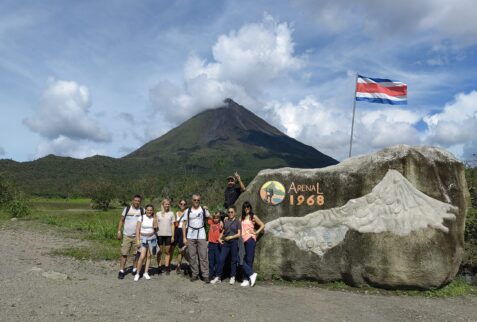

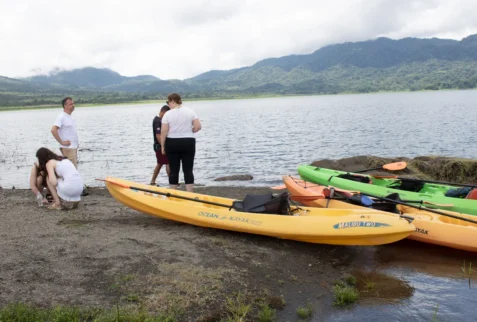

Beach and sun tourism:
The Caribbean area stands out for its variety of aquatic ecosystems and its black and white sand beaches; ideal for the practice of activities focused on nature and the sea, such as sport fishing, diving, enjoying the sun and walks by the sea.
The Pacific coast concentrates large tourist centers and its beaches are preferred for surfing, for example, Esterillos, Jacó, Hermosa, Boca Barranca and near the Marino Ballena National Park and in the Golfito sector, where the famous “ long wave left”.
Adventure
Costa Rica is a land of volcanoes, humid and cloud forests, enormous waterfalls and mighty rivers. This generous nature makes it difficult to decide between the wide range of activities, which include rafting, windsurfing, diving, kayaking, sport fishing and surfing.
For lovers of adventure tourism, Costa Rica is a destination where emotions and adrenaline abound. Throughout the year and in most of the country, whether by water, land or air, you can choose from a wide variety of activities for the whole family, which generally take place in natural settings where you can live memorable experiences.
Due to the excellent characteristics that adventure tourism has in Costa Rica, some international media have distinguished our country as the best adventure destination.
Costa Rica occupies only 0.03 percent of the earth’s surface (it has only 51,100 km2). However, it concentrates about 6 percent of the world’s biodiversity.
Its natural wealth, both in terms of species and ecosystems, is partly explained by its geographical position. Being located between the continental masses of North and South America allowed it, for thousands of years, to be a bridge for countless species of animals and plants. Another factor to take into consideration has been the wide extension of its two coasts: a Caribbean coast of 255 km and one facing the Pacific of 1,103 km; as well as a mountainous system that provides numerous microclimates and a territorial sea of 589,000 km2.
Good to know
Country
Visa Requirement
Spoken languages
currency used
Area (km2)
Culture
Flag
The Costa Rican flag was designed and adopted in 1848, under the presidency of José María Castro Madriz. Since that year, the flag has always been three colors. The First Lady, Pacífica Fernández Oreamuno, designed the Costa Rican flag, inspired by the ideals of the French Revolution – liberty, equality and fraternity – and the colors of the National Flag of France. Each color represents important aspects of Costa Rica: Blue: the sky, the opportunities within reach, intellectual thought, perseverance to achieve a goal, infinity, eternity, and the ideals of religious and spiritual desires. White means thinking clearly, happiness, wisdom, power and the beauty of the sky, the driving force of initiatives for the search for new endeavors, and the peace of Costa Rica. Red represents the warmth of Costa Ricans, their love for life, their bloodshed for freedom, and their generous attitude.
2. National Shield
The Costa Rican coat of arms was adopted on September 29, 1948 and its current version on May 5, 1998.
“Central America” is printed in silver letters on the blue ribbon at the top of the coat of arms. The two myrtle branches in the closure of the coat of arms represent peace in Costa Rica. On the white ribbon that unites the branches, the title “República de Costa Rica” is printed in gold letters. The seven stars above the mountain system represent the seven provinces of Costa Rica.
The mountainous system, which consists of three mountain ranges, is represented by 3 smoking green volcanoes. The mountainous system that crosses the country and an extensive valley between the two oceans that represent the Atlantic and Pacific oceans are observed. The merchant ships that sail in each ocean represent the cultural and commercial exchange between Costa Rica and the rest of the world. The rising sun represents the prosperity of Costa Rica.
The small circles on both sides of the shield represent coffee beans.
3. National Flower
An orchid of a beautiful purple color popularly called “Guaria Morada” was declared a national symbol in 1939.
4. National Tree
A tree called “Guanacaste”, like the province where it is located, was declared a national tree in 1959, as a tribute to the province that decided to join Costa Rica in 1825.
5. National Bird
The Yigüirro was declared a national symbol in 1976. Its beautiful song announces the arrival of the rainy season.
Costa Rican culture
The culture of Costa Rica is varied, initially having influences from indigenous and European culture, later from Afro-Caribbean and Asian culture. There are traditional technologies in the country, agricultural, cultural and religious practices, and beliefs that connect the current population with its indigenous, European and African ancestors in the genetic and cultural fields. Costa Rica is a mestizo country, in which very diverse social communication systems coexist, ranging from Limón Creole to uses and customs of Iberian origin, going through cultures and ways of thinking as dissimilar as Chinese, indigenous or Mennonite.
Literature has given, in addition to beautiful pieces of customs, singular essayists and prose writers; among them the novelists Joaquín García Monge, Carmen Lyra, Carlos Luis Fallas, Joaquín Gutiérrez Mangel and Fabián Dobles, and the poets Aquileo Echeverría, Roberto Brenes Mesén, Isaac Felipe Azofeifa, Julián Marchena, Eunice Odio, Jorge Debravo and Julieta Dobles.
Costa Rica has its own pictorial style, based on the idealization of rural life and landscaping. In the country, there are representatives of the greatest variety of styles and themes, from the academic tradition to impressionism, abstractionism, expressionism, neofiguration and postmodernist painting. Among the painters, mention can be made of Tomás Povedano, Enrique Echandi, Francisco Amighetti, Teodorico Quirós, Fausto Pacheco, Margarita Bertheau, Manuel de la Cruz González, Rafael Ángel García, Jorge Gallardo, Rafa Fernández, Lola Fernández and Max Jiménez.
It has a strong tradition that has its ancestral roots in stone spheres, stone sculptures, jade and pre-Columbian ceramics, a legacy that has subsequently been cultivated and continued by sculptors such as Francisco Zúñiga, Juan Rafael Chacón, Juan Manuel Sánchez, Juan Portuguez Fucigna. , Domingo Ramos, José Sancho, Max Jiménez, Ibo Bonilla and Jorge Jiménez Deredia.
Con la formación de la Orquesta Sinfónica Juvenil las vocaciones afluyeron, y sobrevino la consolidación de la Orquesta Sinfónica Nacional. La danza es una de las disciplinas más populares, y el teatro sigue su impulso de hace varias décadas
El cine, como entretenimiento llegó temprano al país, en 1897, y en sus inicios estuvo íntimamente relacionado con el teatro. Las primeras producciones de imágenes nacionales fueron realizadas por los mismos empresarios extranjeros que venían al país con sus “vistas” y no fue sino hasta 1913 que fotógrafos costarricenses como Amando Céspedes Marín y Manuel Gómez Miralles incursionaron en las imágenes en movimiento. En la última década se ha impulsado la industria del cine con películas como Entre nosotros, El lugar más feliz del mundo, Presos entre otras.
Costa Rica presenta hoy en día una gran cantidad de venas artísticas entre las que se contempla la música, la danza y el baile, el teatro, el cine, la producción cinematográfica y televisiva, la plástica y las letras.
